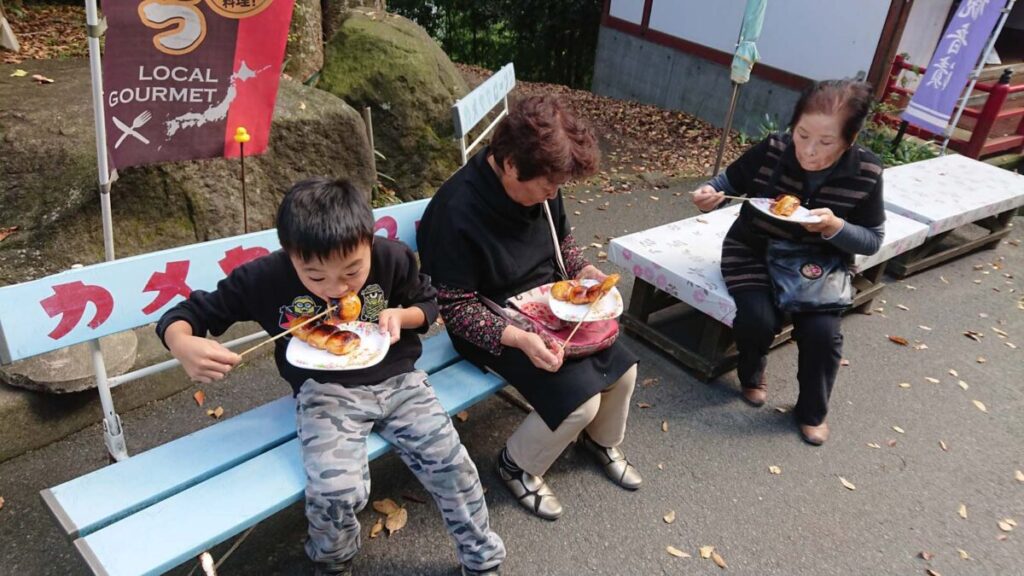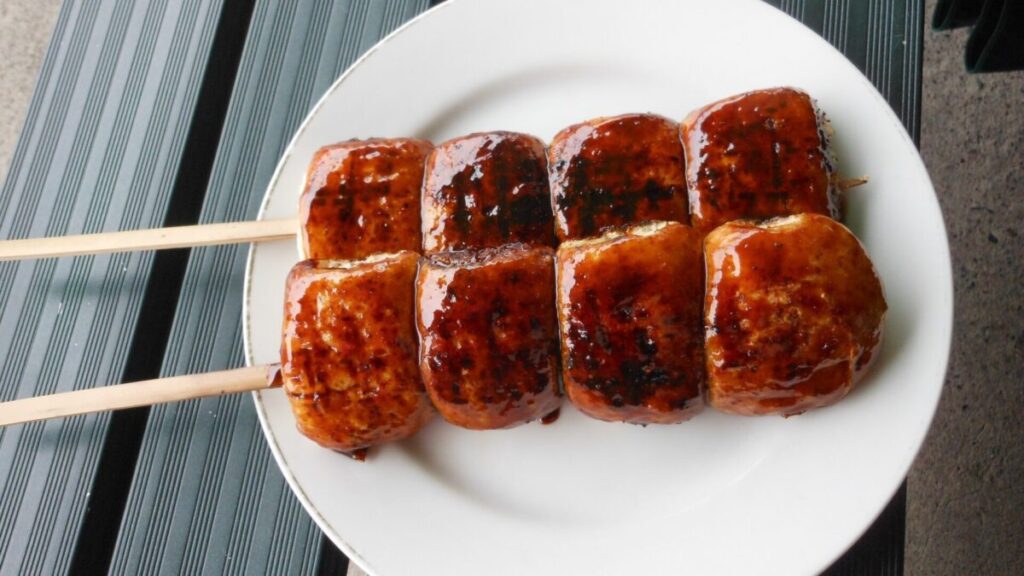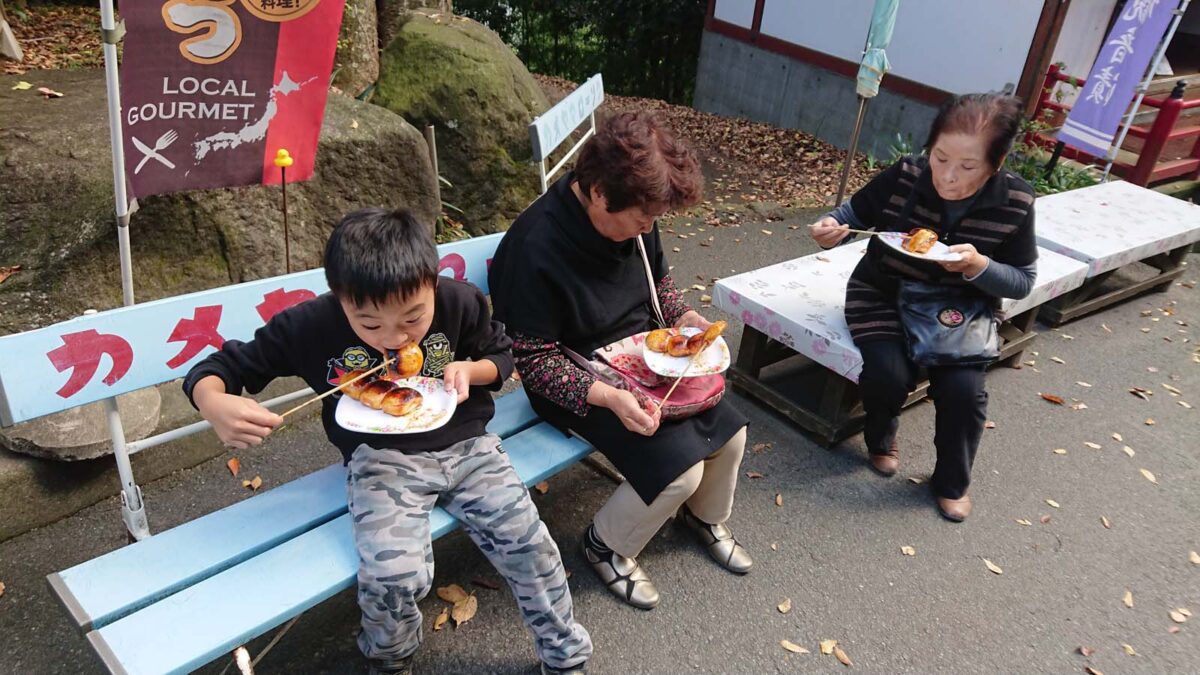
In the northern part of Saitama, where the Second Son’s family home is located, you can savor a local delicacy from Gunma Prefecture known as ‘yakimanju’ (grilled sweet buns).
2-1, who has been visiting Grandpa and Grandma’s house with the Second Son since childhood, has gradually developed a love for yakimanju. Whenever they come across a place selling these delectable treats, they never miss the chance to buy and indulge in them.
Let’s take a closer look at these delightful yakimanju that have become a favorite in the vicinity of the Second Son’s family home.
yakimanju

Nestled in the heart of Japan, Gunma prefecture boasts a vibrant culinary culture, heavily influenced by its thriving wheat production. One of the treasures that has emerged from this land of abundance is the diverse array of local dishes made with wheat flour. Among these, “yakimanju” stands out, a culinary delight that comes in various forms, including the intriguing “soba manju” and “tansan manju.” However, the spotlight shines brightest on the distinctive “yakimanju,” a delicacy created by brushing sweet miso sauce onto manju skewered on bamboo sticks and then grilling them to perfection.
Historical Origins and Festive Delights In the waning years of the Edo period, a visionary named Ruizo Harashima from Maebashi is credited with the creation of the first “miso-dipped manju,” using doburoku, a type of unrefined sake, as a fermentation agent. This innovative approach of skewering manju on bamboo sticks garnered astonishment, laying the foundation for a unique culinary tradition. The miso used at that time, while not particularly sweet, evolved during the Meiji era with the introduction of black honey, transforming the flavor profile to what we savor today.
This delectable treat finds its place on the dining table during various occasions, including cherry blossom viewing and summer festivals. The alluring aroma of freshly grilled yakimanju wafts from food stalls, captivating festivalgoers. Even during the “Hatsuichi” market, a event in Maebashi for business prosperity, yakimanju stalls line the streets. Additionally, souvenir sets featuring yakimanju, miso sauce, chopsticks, and bamboo skewers have been a popular choice for visitors.
The Art of Consumption Crafting yakimanju involves a meticulous process inspired by the “sake manju” method, utilizing koji fermentation. The mixture of wheat flour, mochi rice, and doburoku undergoes fermentation, then steamed to form manju, skewered on bamboo, coated with miso sauce, and finally grilled. Traditionally, one would remove each piece from the skewer and enjoy with chopsticks. In the northern regions like Numata and Tone, sweet-filled yakimanju is also savored, showcasing local variations.
Preservation and Modern Endeavors Recognized as Gunma’s soul food, yakimanju enjoys widespread promotion through platforms such as the official websites of Gunma Prefecture and the Gunma Tourism and Local Products International Association. In a bid to boost national recognition, Takasaki City took the initiative to showcase yakimanju at the “Furusato Matsuri Tokyo” in Tokyo Dome on January 10, 2020, further establishing its presence.
Unveiling the Unique Qualities Yakimanju

Born from the combination of wheat flour and koji fermentation, features a luscious miso glaze enhanced with black sugar or water candy. Best enjoyed warm, the yakimanju is soft and palatable. However, as it cools, the moisture dissipates, rendering it somewhat challenging to bite into. To preserve the freshness, vendors often package the sauce separately for home grilling, catering to those who cherish the warmth of freshly baked yakimanju.
Exploring Historical Roots Tracing its roots back to the late Edo period, yakimanju’s origins are strongly associated with Maebashi, although claims from Isezaki City and Numata City also assert independent founding. Unlike many inventions created for commercial purposes, yakimanju evolved organically from the byproducts of home-brewed sake during a time when households were actively involved in sake production. According to the writings of Kumakozo Harashima, the owner of a renowned yakimanju store in Maebashi, Ruizo Harashima from Ito Village (present-day Ito Town in Maebashi) is credited with introducing yakimanju in 1857, marking its inception.
Regional Influences and Cultural Exchange In the southern regions of Gunma, the thriving winter wheat cultivation, known as “nimanko,” has historically favored wheat-based foods like yakimanju and noodle dishes. This culinary preference has extended beyond Gunma into neighboring areas of Saitama, such as Chichibu City and Nagatoro Town, as well as Ashikaga City in Tochigi Prefecture. The geographical overlap with silk and textile production areas suggests that cultural exchanges between fiber-related industries contributed to the spread of yakimanju in nearby regions.
Gunma and Beyond Situated almost centrally in Japan, Gunma is not the only prefecture savoring the delights of yakimanju. The northern parts of Saitama also embrace this culinary gem, showcasing the broad appeal of this traditional treat beyond provincial borders.
In conclusion, yakimanju encapsulates the essence of Gunma’s culinary heritage, marrying tradition with innovation. Its rich history, diverse flavors, and cultural significance make it a must-try for those seeking a taste of authentic Japanese cuisine. Whether you’re exploring Gunma’s local festivals, savoring the warm aroma at a food stall, or bringing home a souvenir set, yakimanju promises an unforgettable journey through time and flavor.



